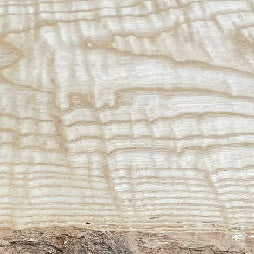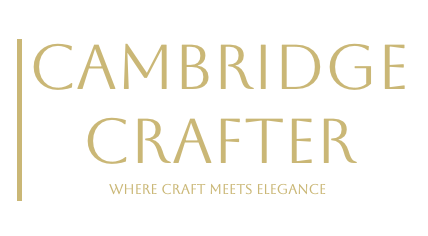
Rippled Ash
Rippled Ash refers to wood from the Fraxinus genus, specifically European Ash (Fraxinus excelsior) in the UK context, which exhibits a rare and highly figured grain pattern known as “rippled” or “fiddleback.” European Ash is a deciduous hardwood tree native to the UK and much of Europe, growing to 50–80 feet tall with trunk diameters of 2–3 feet, commonly found in mixed woodlands, along riverbanks, or on well-drained soils.
The heartwood of Rippled Ash is typically a light creamy brown to pale yellowish, often with a faint greyish tint, while the sapwood is nearly white, blending seamlessly into the heartwood. The “rippled” figuring, also called fiddleback, is what sets this wood apart—it features a wavy, undulating grain pattern that creates a three-dimensional, rippling effect, resembling the surface of water or the tight, regular waves seen in fiddleback maple. This figuring is most visible when the wood is quartersawn, with the ripples running perpendicular to the growth rings, often accompanied by darker streaks or faint olive-brown lines that add contrast. The texture is coarse, typical of ash, with a pronounced, open grain and a subtle natural lustre.
Rippled Ash has a density of around 650–700 kg/m³, making it a hard, strong, and notably elastic wood, with excellent shock resistance—properties that make ash a favourite for tool handles and sports equipment. It’s moderately durable, with poor natural resistance to moisture and insects, so it’s best suited for indoor applications unless treated. The rippled grain can make it slightly more challenging to work than straight-grained ash, as it’s prone to tearout during planing or sawing, requiring sharp tools and careful handling. It glues, stains, and finishes well, with the rippled figuring often highlighted by a clear finish, such as oil or lacquer, which enhances its chatoyancy (a shimmering, light-reflecting quality).
When worked, Rippled Ash has a faint, neutral scent, typical of ash, with no strong aroma. In the UK, it’s prized for high-end decorative uses, such as furniture, cabinetry, and veneer, where its unique figuring can be showcased—particularly in pieces like dining tables or chair backs. The fiddleback pattern makes it a popular choice for musical instruments, such as violin backs (hence the term “fiddleback”), and for bespoke joinery, where its aesthetic appeal adds a touch of elegance. It’s also used for turned objects like bowls or spindles, often seen in British craftsmanship for its combination of beauty and workability.
Rippled Ash is rarer and more expensive than straight-grained ash due to the scarcity of the fiddleback figuring, which occurs naturally in only a small percentage of trees. Fraxinus excelsior is not listed on CITES Appendices, but it faces challenges in the UK from ash dieback (Hymenoscyphus fraxineus), a fungal disease that has significantly reduced populations since the 2010s, and the emerald ash borer, further threatening supply. The IUCN lists it as near-threatened due to these pressures. In the UK, Rippled Ash is often sourced from sustainable forestry or salvaged trees, making it a premium material for projects where its striking visual effect can be the focal point.
